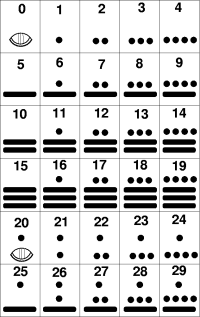Maya numerals
|
|
The Pre-Columbian Maya civilization used a vigesimal (base-20) numeral system. Template:Table Numeral Systems

The numerals are made up of three symbols; zero (shell shape), one (a dot) and five (a bar).
For example, 19 is written as four dots in a horizontal row above three horizontal lines stacked upon each other.
Digits are stacked with the higher significant digits at the top. Thus, two dots above each other would be read as 1ײ0 + 1 = 21.
Other than the bar and dot notation, Maya numerals can be illustrated by face type glyphs. The face glyph for a number represents the deity associated with the number. These face number glyphs were rarely used, and are mostly seen only on some of the most elaborate monumental carving.
In the calendar
In the "Long count" portion of the Maya calendar, a variation on the strictly vigesimal numbering is used. The long count changes the second place value; it is not 20ײ0 = 400, as would be expected, but 18ײ0, so that one dot over two zeros signifies 360. This is supposed to be because 360 is roughly the number of days in a year. (Some hypothesize that this was an early approximation to the number of days in the solar year, although the Maya had a quite accurate calculation of 365.2422 days for the solar year at least since the early Classic era). Subsequent place values return to base 20.
